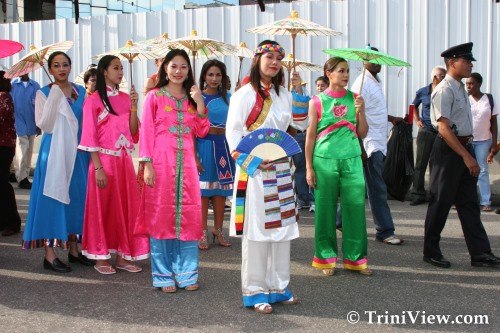 A display of Chinese dance and culture
A display of Chinese dance and culture
By Dr. Kumar Mahabir
October 07, 2006
It is more than a coincidence that Chinese, Hindus and Muslims will each have national holidays in their honour this October in Trinidad and Tobago.
Chinese Arrival will be celebrated as a public holiday on October 12, Divali Festival of Lights on October 21, and Eid-ul-Fitr thanksgiving will be observed on October 23, 2006.
The majority of Hindus and Muslims are of Indian descent, and Indians make up 40 percent of the population. Hindus comprise 24 percent of the total population and Muslims six percent. Chinese citizens constitute less than one percent of the inhabitants, but they are highly visible in business, banking and politics.
Like Divali and Eid, the Chinese Bicentennial Celebrations will be observed as a time of goodwill, understanding, friendship, and the strengthening of family and communal ties. There will be tons of tasty traditional foods, and participants will dress in resplendent ethnic wear.
As a part of the Chinese and Divali celebrations, firecrackers will explode in the air. The Chinese dragon will emerge to dance, which like the Hindu Mother Lakshmi, is a symbol of prosperity.
The first batch of Indians came to work in the Caribbean as indentured labourers in the sugarcane plantations in 1838 after the abolition of African slavery. Indian Arrival Day is observed as a national holiday every year in commemoration of their presence and contribution to the society and economy.
The first group of Chinese immigrants arrived as indentured labourers in Trinidad on October 12, 1806 in a company vessel owned by the East India Company.
Since then, Chinese came to work in the sugar plantations in the French Antilles, Suriname, Jamaica, British Guiana and Trinidad.
In 1855, one writer expressed opposition to the continued entry of Chinese and Indians in the colony of Jamaica. He wrote "If we are to have immigrants, let us have them of the right sort, families who are of civilized habits, of Christianised principles, and of sound moral character. We have had enough of Chinese and Indian idolaters."
They were referred to as "Chinese coolies" and shared with Indians the social and cultural trauma of being in a new environment far away from home in an atmosphere hostile to non-Christians and non-whites.
The 1870-71 British Guiana Commission Report states that a few Indians had even picked up the habit of opium smoking from the Chinese, among whom it was widespread. They were put in the same jails with Indian indentured labourers, and for the same reason of refusing to work under inhumane conditions on the plantation.
As early as the 1850s in Trinidad, Chinese traders established a business partnership with the Indian market vendors who bought the carrots, turnips and cabbages they cultivated.
According to Walton Look Lai in his book "Indentured Labour, Caribbean Sugar: Chinese and Indian Migrants to the British West Indies, 1838-1981 (1993)", the majority of Chinese men chose to become permanent bachelors because of the scarcity of Chinese women. Though the majority of men in sexual unions formed relationships with African women in the estates, some of them had Indian wives.
In 1891, a British Government official observed: "It is not an un-common thing to find a "coolie" woman living with a Chinaman as his wife, and in one or two instances the woman has accompanied her reputed husband to China."
The percentage of Chinese men who entered racially mixed relationships, however, was not more than 17 to 20 percent.
In his book West Indian Societies (1972), David Lowenthal states that the Chinese, like the Indian immigrants, internalised the European criteria of beauty which placed high value on straight hair and light skin. Preference was, therefore, given to mates who had non-Negroid physical features.
During indentureship, Chinese workers even formed alliances with Indian labourers in the estates when it was to their advantage to win higher wages and better working conditions. In 1865, for example, in an inter-estate clash between labourers of Endeavour and Woodford Lodge, they joined Indians in one estate against Indians and Blacks in another.
Unlike Africans, Indians have always established a cordial relationship with the Chinese in the Caribbean. In Jamaica in 1965, when an African worker was allegedly mistreated, a racist riot erupted in which Chinese stores were looted and burned.
Like Indian business people, Chinese have been accused of being stingy and employing only their family. Their educational and commercial successes have also excited envy as well as admiration.
The Chinese Bicentennial in T and T in pictures:
www.triniview.com/gallery/main.php?g2_itemId=92665
Homepage | Chinese Bicentennial | Special Events | Photo Gallery
|
